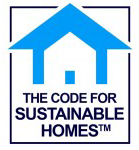The Credits
 The Code Assessment measures and certifies The environmental performance of new homes. It is THE Recognised Governments standard in the design and construction of new homes and will encourage the continuous improvement in sustainable home building.
The Code Assessment measures and certifies The environmental performance of new homes. It is THE Recognised Governments standard in the design and construction of new homes and will encourage the continuous improvement in sustainable home building.
The Code measures the sustainability of a home against nine design categories as listed below, within each of the nine categories there are sub categories, some of these areas are mandatory, all these issues are used to assess the whole home as a performance and environmental standard to produce a code level. The current minimum level is Level 3.
The nine design categories with their sub categories are:
1. Energy and CO2 emissions
- Dwelling emission rate (Mandatory)
- Building fabric
- Internal lighting
- Drying space
- Energy labelled white goods
- External lighting
- Low or zero carbon (LZC) technologies
- Cycle storage
- Home office
2. Water
- Indoor water use (Mandatory)
- External water use
3. Materials Environmental impact of materials (Mandatory)
- Responsible sourcing of materials – basic building elements
- Responsible sourcing of materials – finishing elements
4. Surface Water Run-off
- Management of Surface Water Runoff from developments (M)
- Flood risk
5. Waste
- Storage of non-recyclable waste and recyclable household waste (M)
- Construction waste management (M)
- Composting
6. Pollution
- Global warming potential (GWP) of insulants
- NOX emissions
7. Health and Well-being
- Daylighting
- Sound insulation
- Private space
- Lifetime homes (M)
8. Management
- Home user guide
- Considerate constructors scheme
- Construction site impacts
- Security
9. Ecology
- Ecological value of site
- Ecological enhancement
- Protection of ecological features
- Change in ecological value of site
- Building footprint
Credits are awarded for various issues within each category. The total credits overall determines the Code level: